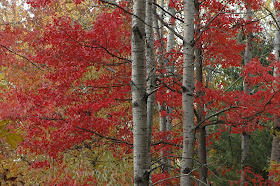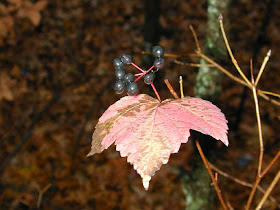Tuesday, October 16, 2012
Woo-hoo! a pageview milestone
Well after two years 'on the air', I just passed 100,000 hits. Even though I know most of those are from Google and Yahoo searches and not direct visits, it's still cool. Kind of exciting, but then I see last week Jim McCormac at Ohio Birds and Biodiversity just passed the one million hit mark. Well, maybe someday........
Sunday, October 14, 2012
Blast the Chloroplast, I've had my Fill of Chlorophyl
Autumn is upon us, and the green leaves are starting to disappear. Sunday was too nice a day to sit inside, so I took off to shoot the leaf change, and still made it back to actually see the Browns win a game. Nothing special in this post today, just a slide show. Then again, red, green, yellow, pink, orange, maroon, and scarlet mixed together really can be kind of special.
Red Maple Acer rubrum, in a grove of Big-tooth Aspen, Populus grandidentata. I wish I had taken more shots like this, but the rest are just closeups. Photosynthesis is coming to a halt, and the true colors of the leaves are seeping through. These are all shots of woody plants found in our common oak-hickory and beech-maple forests.
Here's a series of Red Maple as it goes through its color changes.
While we may not be New England, we still have a lot to brag about in S.E. Ohio during foliage change. This is Sugar Maple, Acer saccharum. Though it is mostly known for its yellow color contribution, this maple will also have red tints.
Black Maple, Acer nigrum. Considered a valid species by some, and just a Sugar Maple variety by others. Either way, the colors of Black Maple can be striking.
Rainbow Sherbert anyone?
Smooth Sumac, Rhus glabra.
Winged Sumac, Rhus copallina.
Maple-leaf Viburnum, Viburnum acerifolium. Looking similar to Red Maple, these leaves are covered in soft velvety hairs. You can see those hairs on the leaf petiole. Viburnum fruits are drupes, not samaras, the papery winged fruit of maple.
Flowering Dogwood, Cornus florida.
Dewberry, Rubus sp. Dewberries are a type of Blackberry that grows along the ground rather than upright.
Sourwood, Oxydendrum arboreum. Sourwood leaves can be pink and orange as well as red. The margins on young saplings have fine serrations. On older plants, the leaves will be serrate only on the upper half.
Mockernut Hickory, Carya tomentosa.
Though not as bright as the maples, the oaks add their own shades of color to our hillsides. This is White Oak, Quercus alba.
Chestnut Oak, Quercus montana (prinus).
Black Oak, Quercus velutina.
Red Oak, Quercus rubra.
How about a little purple? This is Biltmore Ash, Fraxinus americana x biltmoreana. This is a green and white ash hybrid found on dry ridgetops. Green Ash leaves turn yellow in the fall, while White Ash turns purple.
Pawpaw, Asimina triloba.
Beech, Fagus grandifolia. I didn't know Pawpaw and Beech turned black in the fall? Well they don't. If you have followed the news, or my blog, you'll know this is the Black Sooty Mold, caused by the large outbreak of this years Tulip-tree Scale insect.
The oblique or uneven leaf bases and the stalked naked buds are visible on this Witch-hazel, Hamamelis virginiana. Those identification keys are overshadowed by the yellow flowers that bloom in October. These spider like petals add a "different" kind of yellow to the forest.
Protruding next to the flowers is this aphid gall common on Witch-hazel. The spiny points will separate it from the similar looking fruit capsule.
Red Maple Acer rubrum, in a grove of Big-tooth Aspen, Populus grandidentata. I wish I had taken more shots like this, but the rest are just closeups. Photosynthesis is coming to a halt, and the true colors of the leaves are seeping through. These are all shots of woody plants found in our common oak-hickory and beech-maple forests.
Here's a series of Red Maple as it goes through its color changes.
While we may not be New England, we still have a lot to brag about in S.E. Ohio during foliage change. This is Sugar Maple, Acer saccharum. Though it is mostly known for its yellow color contribution, this maple will also have red tints.
Black Maple, Acer nigrum. Considered a valid species by some, and just a Sugar Maple variety by others. Either way, the colors of Black Maple can be striking.
Rainbow Sherbert anyone?
Smooth Sumac, Rhus glabra.
Winged Sumac, Rhus copallina.
Maple-leaf Viburnum, Viburnum acerifolium. Looking similar to Red Maple, these leaves are covered in soft velvety hairs. You can see those hairs on the leaf petiole. Viburnum fruits are drupes, not samaras, the papery winged fruit of maple.
Flowering Dogwood, Cornus florida.
Dewberry, Rubus sp. Dewberries are a type of Blackberry that grows along the ground rather than upright.
Sourwood, Oxydendrum arboreum. Sourwood leaves can be pink and orange as well as red. The margins on young saplings have fine serrations. On older plants, the leaves will be serrate only on the upper half.
Mockernut Hickory, Carya tomentosa.
Though not as bright as the maples, the oaks add their own shades of color to our hillsides. This is White Oak, Quercus alba.
Chestnut Oak, Quercus montana (prinus).
Black Oak, Quercus velutina.
Red Oak, Quercus rubra.
How about a little purple? This is Biltmore Ash, Fraxinus americana x biltmoreana. This is a green and white ash hybrid found on dry ridgetops. Green Ash leaves turn yellow in the fall, while White Ash turns purple.
Pawpaw, Asimina triloba.
Beech, Fagus grandifolia. I didn't know Pawpaw and Beech turned black in the fall? Well they don't. If you have followed the news, or my blog, you'll know this is the Black Sooty Mold, caused by the large outbreak of this years Tulip-tree Scale insect.
The oblique or uneven leaf bases and the stalked naked buds are visible on this Witch-hazel, Hamamelis virginiana. Those identification keys are overshadowed by the yellow flowers that bloom in October. These spider like petals add a "different" kind of yellow to the forest.
Protruding next to the flowers is this aphid gall common on Witch-hazel. The spiny points will separate it from the similar looking fruit capsule.
Friday, October 5, 2012
Prairies: Part 1, site indicators
When I see Purple Coneflower Echinacea purpurea, the prairie grasslands always come to mind. I have come across two other species similar to this, but this is the most common.
While the largest forest type in North America may be the Boreal Forest, the largest ecotype was historically the prairies. Much of the original grasslands no longer exist. The midwest and great plains have some of the richest agricultural soils, so it's hard to criticize the breadbasket of the world for plowing them under.
Prairies are dominated by herbaceous plants, not trees and shrubs. Grasslands that do contain trees, usually scrub oaks, can be found further south in Oklahoma and Texas. These are called savannas. Ohio still contains some original prairie remnants. Most of these are protected as nature preserves. Tall grass prairies reach their eastern most extension around Ohio. Closer to the Rocky Mountains are the Short grass prairies (due to lack of rain). Where the two meet you get Mixed prairie.
For educational purposes, many metro parks and nature centers are establishing their own prairies from scratch. You can purchase seed packs, hope for donation of seed (thanks Hamilton County Parks), or directly collect seed from the field. I have gathered seed both in and out of state. If you are growing these for demonstration only, I'm not picky about where the seed comes from. BUT, if you are managing original historic prairie, you should never introduce seed from another region. The genetics may be too different.
So exactly where would you put a prairie if you wanted one? Well there are a half dozen different soil types and topographic conditions ideal for prairies. Without conducting soil tests, I just look at what I call indicator species. Plants that often grow in prairies, but are not restricted or prairie obligates. In most places these sites are slightly upland and drier. None of this is in stone, I'm just basing this on my own experience. There will always be differences depending upon where you are located. One of those indicators is the Butterfly Milkweed, Asclepias tuberosa, the orange flower above. I also commonly see the Virginia and Narrow-leaved Mountain Mints, Pycnanthemum.
The following are more photos of species I have always thought were ideal locations for a prairie, or flowers already associated with one. I welcome any comments on my particular choices. This is Flowering Spurge, Euphorbia corollata.
Partridge Pea, Chamaecrista fasciculata.
Field Milkwort, Polygala sanguinea.
Yellow Flax, Linum sulcatum.
Slender Gerardia, Agalinis tenuifolia.
Rose Pink, Sabatia angularis.
Heal-all or Self-heal, Prunella vulgaris.
Wild Bergamot, Monarda fistulosa.
Wild Senna, Senna (Cassia) hebecarpa.
Rattlebox, Crotalaria sagittalis.
Biennial Gaura, Gaura biennis.
While the largest forest type in North America may be the Boreal Forest, the largest ecotype was historically the prairies. Much of the original grasslands no longer exist. The midwest and great plains have some of the richest agricultural soils, so it's hard to criticize the breadbasket of the world for plowing them under.
Prairies are dominated by herbaceous plants, not trees and shrubs. Grasslands that do contain trees, usually scrub oaks, can be found further south in Oklahoma and Texas. These are called savannas. Ohio still contains some original prairie remnants. Most of these are protected as nature preserves. Tall grass prairies reach their eastern most extension around Ohio. Closer to the Rocky Mountains are the Short grass prairies (due to lack of rain). Where the two meet you get Mixed prairie.
For educational purposes, many metro parks and nature centers are establishing their own prairies from scratch. You can purchase seed packs, hope for donation of seed (thanks Hamilton County Parks), or directly collect seed from the field. I have gathered seed both in and out of state. If you are growing these for demonstration only, I'm not picky about where the seed comes from. BUT, if you are managing original historic prairie, you should never introduce seed from another region. The genetics may be too different.
So exactly where would you put a prairie if you wanted one? Well there are a half dozen different soil types and topographic conditions ideal for prairies. Without conducting soil tests, I just look at what I call indicator species. Plants that often grow in prairies, but are not restricted or prairie obligates. In most places these sites are slightly upland and drier. None of this is in stone, I'm just basing this on my own experience. There will always be differences depending upon where you are located. One of those indicators is the Butterfly Milkweed, Asclepias tuberosa, the orange flower above. I also commonly see the Virginia and Narrow-leaved Mountain Mints, Pycnanthemum.
The following are more photos of species I have always thought were ideal locations for a prairie, or flowers already associated with one. I welcome any comments on my particular choices. This is Flowering Spurge, Euphorbia corollata.
Partridge Pea, Chamaecrista fasciculata.
Field Milkwort, Polygala sanguinea.
Yellow Flax, Linum sulcatum.
Slender Gerardia, Agalinis tenuifolia.
Rose Pink, Sabatia angularis.
Heal-all or Self-heal, Prunella vulgaris.
Wild Bergamot, Monarda fistulosa.
Wild Senna, Senna (Cassia) hebecarpa.
Rattlebox, Crotalaria sagittalis.
Biennial Gaura, Gaura biennis.






















































